Analyzing Multiculturalism's Impact on Canadian National Unity
VerifiedAdded on 2023/04/11
|9
|2188
|468
Essay
AI Summary
This essay examines the intricate relationship between multiculturalism and national unity in Canada, highlighting the evolution of multiculturalism from the 1970s under Prime Minister Pierre Trudeau to its formal recognition through the Canadian Multiculturalism Act. It discusses how government policies, such as the Quebec Act, the Charter of Rights and Freedom, and the Broadcasting Act, have fostered an environment of equality and social cohesion. The essay further analyzes the economic benefits of multiculturalism, noting the significant contributions of immigrants to Canadian business and trade relations. It also explores how multiculturalism has shaped Canadian social identity, promoting a hybrid culture that values diversity and egalitarian principles. While acknowledging challenges such as distorted nationalism and cultural supremacy, the essay concludes that multiculturalism is a driving force behind Canada's national unity, promoting economic growth, social harmony, and a global perspective. Desklib offers a wealth of similar academic resources for students.
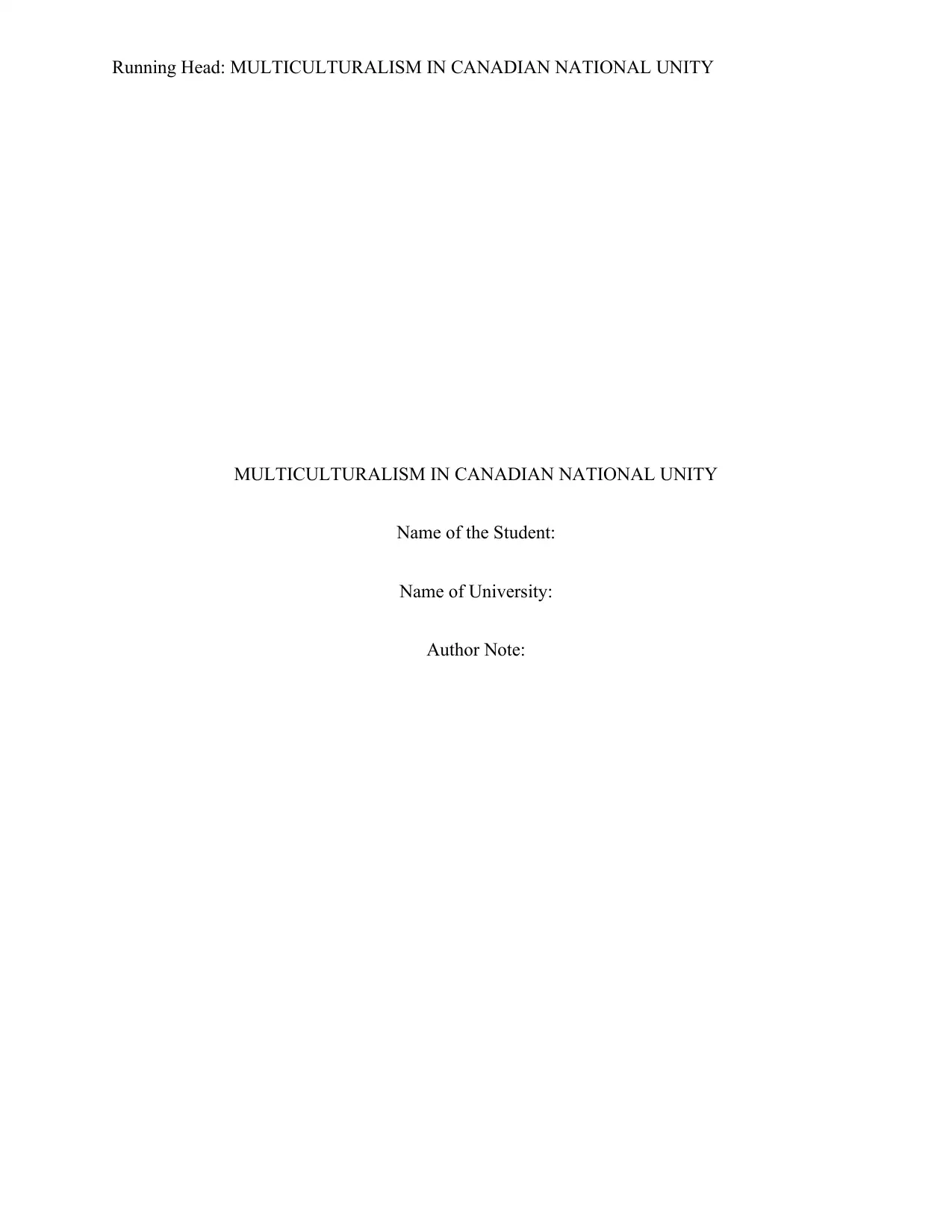
Running Head: MULTICULTURALISM IN CANADIAN NATIONAL UNITY
MULTICULTURALISM IN CANADIAN NATIONAL UNITY
Name of the Student:
Name of University:
Author Note:
MULTICULTURALISM IN CANADIAN NATIONAL UNITY
Name of the Student:
Name of University:
Author Note:
Paraphrase This Document
Need a fresh take? Get an instant paraphrase of this document with our AI Paraphraser
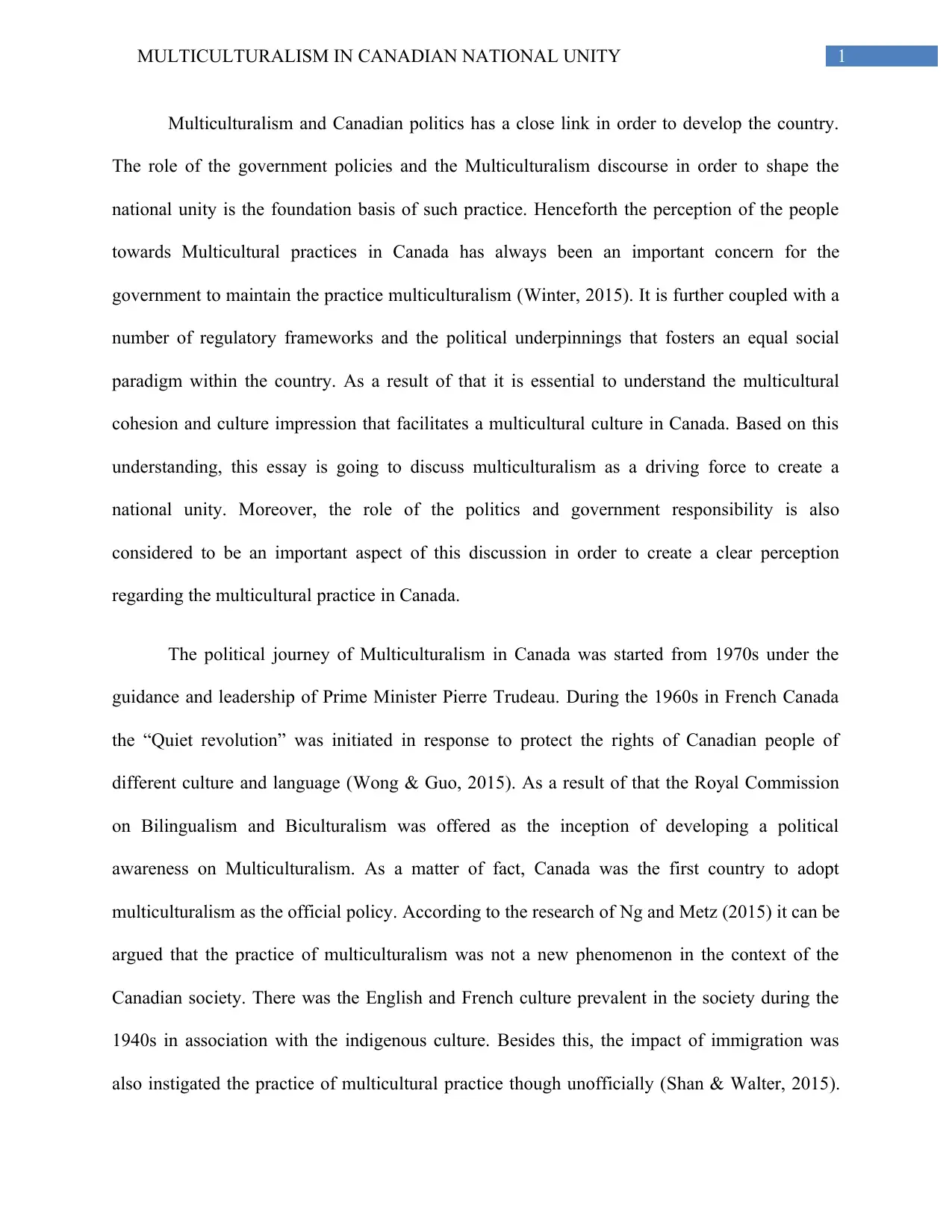
1MULTICULTURALISM IN CANADIAN NATIONAL UNITY
Multiculturalism and Canadian politics has a close link in order to develop the country.
The role of the government policies and the Multiculturalism discourse in order to shape the
national unity is the foundation basis of such practice. Henceforth the perception of the people
towards Multicultural practices in Canada has always been an important concern for the
government to maintain the practice multiculturalism (Winter, 2015). It is further coupled with a
number of regulatory frameworks and the political underpinnings that fosters an equal social
paradigm within the country. As a result of that it is essential to understand the multicultural
cohesion and culture impression that facilitates a multicultural culture in Canada. Based on this
understanding, this essay is going to discuss multiculturalism as a driving force to create a
national unity. Moreover, the role of the politics and government responsibility is also
considered to be an important aspect of this discussion in order to create a clear perception
regarding the multicultural practice in Canada.
The political journey of Multiculturalism in Canada was started from 1970s under the
guidance and leadership of Prime Minister Pierre Trudeau. During the 1960s in French Canada
the “Quiet revolution” was initiated in response to protect the rights of Canadian people of
different culture and language (Wong & Guo, 2015). As a result of that the Royal Commission
on Bilingualism and Biculturalism was offered as the inception of developing a political
awareness on Multiculturalism. As a matter of fact, Canada was the first country to adopt
multiculturalism as the official policy. According to the research of Ng and Metz (2015) it can be
argued that the practice of multiculturalism was not a new phenomenon in the context of the
Canadian society. There was the English and French culture prevalent in the society during the
1940s in association with the indigenous culture. Besides this, the impact of immigration was
also instigated the practice of multicultural practice though unofficially (Shan & Walter, 2015).
Multiculturalism and Canadian politics has a close link in order to develop the country.
The role of the government policies and the Multiculturalism discourse in order to shape the
national unity is the foundation basis of such practice. Henceforth the perception of the people
towards Multicultural practices in Canada has always been an important concern for the
government to maintain the practice multiculturalism (Winter, 2015). It is further coupled with a
number of regulatory frameworks and the political underpinnings that fosters an equal social
paradigm within the country. As a result of that it is essential to understand the multicultural
cohesion and culture impression that facilitates a multicultural culture in Canada. Based on this
understanding, this essay is going to discuss multiculturalism as a driving force to create a
national unity. Moreover, the role of the politics and government responsibility is also
considered to be an important aspect of this discussion in order to create a clear perception
regarding the multicultural practice in Canada.
The political journey of Multiculturalism in Canada was started from 1970s under the
guidance and leadership of Prime Minister Pierre Trudeau. During the 1960s in French Canada
the “Quiet revolution” was initiated in response to protect the rights of Canadian people of
different culture and language (Wong & Guo, 2015). As a result of that the Royal Commission
on Bilingualism and Biculturalism was offered as the inception of developing a political
awareness on Multiculturalism. As a matter of fact, Canada was the first country to adopt
multiculturalism as the official policy. According to the research of Ng and Metz (2015) it can be
argued that the practice of multiculturalism was not a new phenomenon in the context of the
Canadian society. There was the English and French culture prevalent in the society during the
1940s in association with the indigenous culture. Besides this, the impact of immigration was
also instigated the practice of multicultural practice though unofficially (Shan & Walter, 2015).

2MULTICULTURALISM IN CANADIAN NATIONAL UNITY
As a result of that during the inauguration of multiculturalism as an official policy of the
Canadian government, a thorough justification was also illustrate in order to clarify the
rationality of such a step. A feeling of security and self-confidence is coupled with the
government policy on multiculturalism that pushed the government to enact the Canadian
Multiculturalism Act in 1988. Moreover, section 27 of the Canadian Charter of Rights and
Freedom in association with the Department of Canadian Heritage is also responsible to facilitate
a better regulatory support to the government policy (Kymlicka, 2015). As a matter of fact, the
Broadcasting Act of 19991 was also adopted in order to create a popular psyche regarding the
effective practice of multiculturalism within the country (Houshmand, Spanierman & Tafarodi,
2014). Significantly, the government initiatives are highly relevant in order to establish an
effective multicultural practice and formulate a hospitable environment where all the citizens can
share equal rights and opportunities.
In this regard, it is essential to figure out the relationship between multicultural practice
and national unity in Canada. Therefore, the impact of multiculturalism in social, political and
economic aspect is pertinent that plays like a catalyst to develop the national unity in Canada. As
an official policy of the Canadian government in the yearly 1970s, multicultural connoted the
sense of a pan-Canadian nationhood (Bloemraad & Wright, 2014). It was associated with the
Quebecois nationalist sentiment that aggravated the political intention of the government of
Canada. Identity plays a significant role in this regard where both the pan-Canadian sentiment
and the identity of particular culture have been flourished side by side. It is also coupled with the
concept of post-nationalist thoughts and ideologies that cemented a political interest behind the
government intervention. In this context, immigration is considered to be one of the major factor
for developing a society based on the equal rights. Henceforth, the government also stages a
As a result of that during the inauguration of multiculturalism as an official policy of the
Canadian government, a thorough justification was also illustrate in order to clarify the
rationality of such a step. A feeling of security and self-confidence is coupled with the
government policy on multiculturalism that pushed the government to enact the Canadian
Multiculturalism Act in 1988. Moreover, section 27 of the Canadian Charter of Rights and
Freedom in association with the Department of Canadian Heritage is also responsible to facilitate
a better regulatory support to the government policy (Kymlicka, 2015). As a matter of fact, the
Broadcasting Act of 19991 was also adopted in order to create a popular psyche regarding the
effective practice of multiculturalism within the country (Houshmand, Spanierman & Tafarodi,
2014). Significantly, the government initiatives are highly relevant in order to establish an
effective multicultural practice and formulate a hospitable environment where all the citizens can
share equal rights and opportunities.
In this regard, it is essential to figure out the relationship between multicultural practice
and national unity in Canada. Therefore, the impact of multiculturalism in social, political and
economic aspect is pertinent that plays like a catalyst to develop the national unity in Canada. As
an official policy of the Canadian government in the yearly 1970s, multicultural connoted the
sense of a pan-Canadian nationhood (Bloemraad & Wright, 2014). It was associated with the
Quebecois nationalist sentiment that aggravated the political intention of the government of
Canada. Identity plays a significant role in this regard where both the pan-Canadian sentiment
and the identity of particular culture have been flourished side by side. It is also coupled with the
concept of post-nationalist thoughts and ideologies that cemented a political interest behind the
government intervention. In this context, immigration is considered to be one of the major factor
for developing a society based on the equal rights. Henceforth, the government also stages a
⊘ This is a preview!⊘
Do you want full access?
Subscribe today to unlock all pages.

Trusted by 1+ million students worldwide
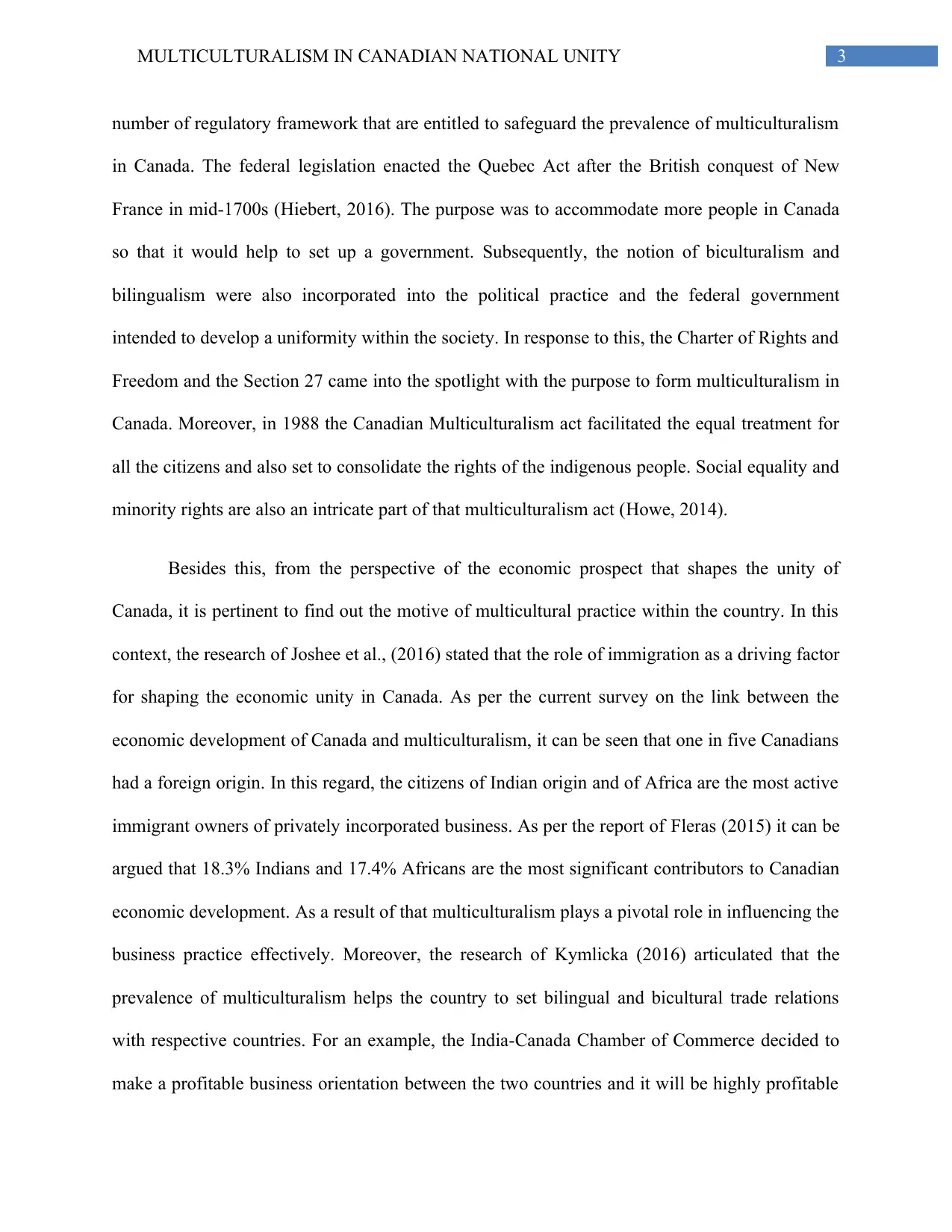
3MULTICULTURALISM IN CANADIAN NATIONAL UNITY
number of regulatory framework that are entitled to safeguard the prevalence of multiculturalism
in Canada. The federal legislation enacted the Quebec Act after the British conquest of New
France in mid-1700s (Hiebert, 2016). The purpose was to accommodate more people in Canada
so that it would help to set up a government. Subsequently, the notion of biculturalism and
bilingualism were also incorporated into the political practice and the federal government
intended to develop a uniformity within the society. In response to this, the Charter of Rights and
Freedom and the Section 27 came into the spotlight with the purpose to form multiculturalism in
Canada. Moreover, in 1988 the Canadian Multiculturalism act facilitated the equal treatment for
all the citizens and also set to consolidate the rights of the indigenous people. Social equality and
minority rights are also an intricate part of that multiculturalism act (Howe, 2014).
Besides this, from the perspective of the economic prospect that shapes the unity of
Canada, it is pertinent to find out the motive of multicultural practice within the country. In this
context, the research of Joshee et al., (2016) stated that the role of immigration as a driving factor
for shaping the economic unity in Canada. As per the current survey on the link between the
economic development of Canada and multiculturalism, it can be seen that one in five Canadians
had a foreign origin. In this regard, the citizens of Indian origin and of Africa are the most active
immigrant owners of privately incorporated business. As per the report of Fleras (2015) it can be
argued that 18.3% Indians and 17.4% Africans are the most significant contributors to Canadian
economic development. As a result of that multiculturalism plays a pivotal role in influencing the
business practice effectively. Moreover, the research of Kymlicka (2016) articulated that the
prevalence of multiculturalism helps the country to set bilingual and bicultural trade relations
with respective countries. For an example, the India-Canada Chamber of Commerce decided to
make a profitable business orientation between the two countries and it will be highly profitable
number of regulatory framework that are entitled to safeguard the prevalence of multiculturalism
in Canada. The federal legislation enacted the Quebec Act after the British conquest of New
France in mid-1700s (Hiebert, 2016). The purpose was to accommodate more people in Canada
so that it would help to set up a government. Subsequently, the notion of biculturalism and
bilingualism were also incorporated into the political practice and the federal government
intended to develop a uniformity within the society. In response to this, the Charter of Rights and
Freedom and the Section 27 came into the spotlight with the purpose to form multiculturalism in
Canada. Moreover, in 1988 the Canadian Multiculturalism act facilitated the equal treatment for
all the citizens and also set to consolidate the rights of the indigenous people. Social equality and
minority rights are also an intricate part of that multiculturalism act (Howe, 2014).
Besides this, from the perspective of the economic prospect that shapes the unity of
Canada, it is pertinent to find out the motive of multicultural practice within the country. In this
context, the research of Joshee et al., (2016) stated that the role of immigration as a driving factor
for shaping the economic unity in Canada. As per the current survey on the link between the
economic development of Canada and multiculturalism, it can be seen that one in five Canadians
had a foreign origin. In this regard, the citizens of Indian origin and of Africa are the most active
immigrant owners of privately incorporated business. As per the report of Fleras (2015) it can be
argued that 18.3% Indians and 17.4% Africans are the most significant contributors to Canadian
economic development. As a result of that multiculturalism plays a pivotal role in influencing the
business practice effectively. Moreover, the research of Kymlicka (2016) articulated that the
prevalence of multiculturalism helps the country to set bilingual and bicultural trade relations
with respective countries. For an example, the India-Canada Chamber of Commerce decided to
make a profitable business orientation between the two countries and it will be highly profitable
Paraphrase This Document
Need a fresh take? Get an instant paraphrase of this document with our AI Paraphraser
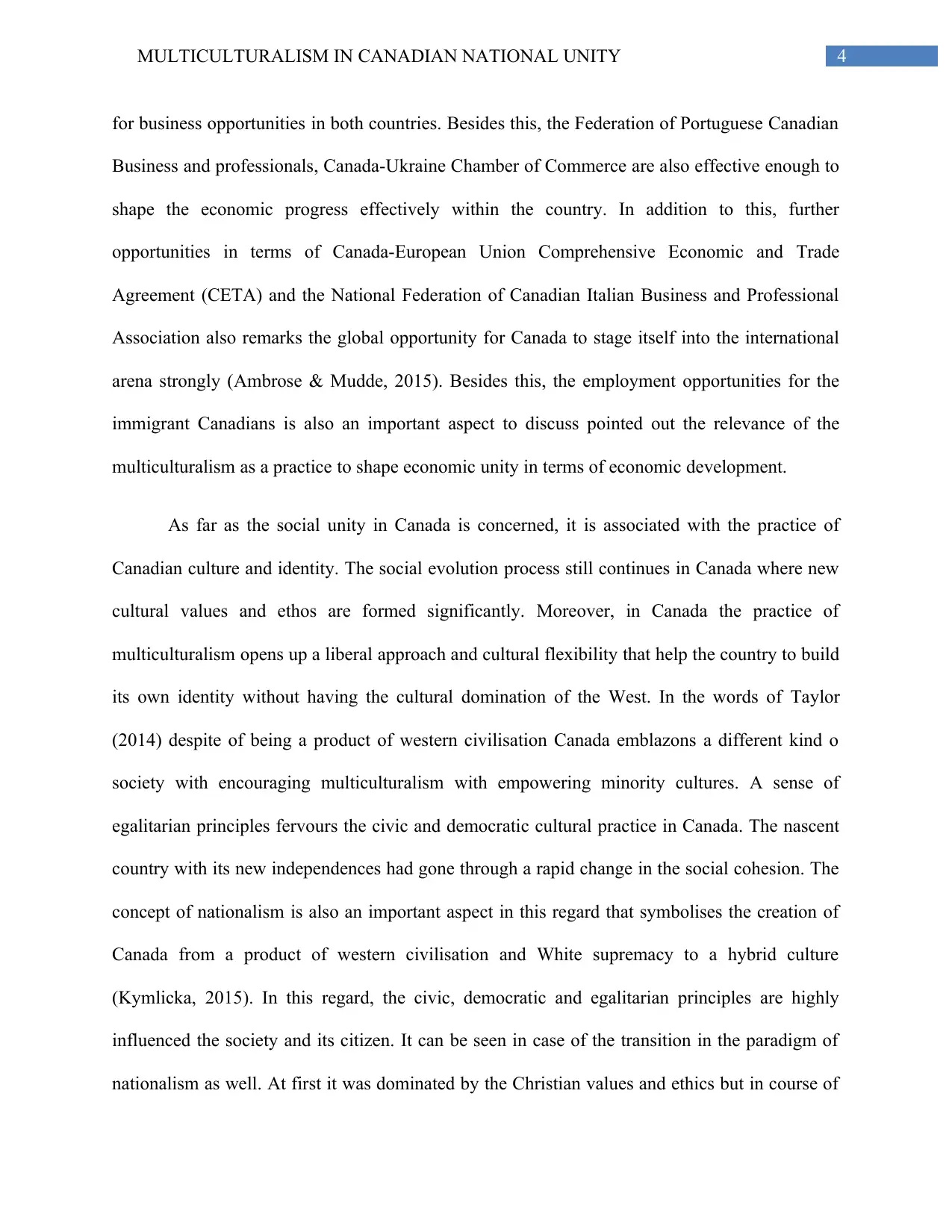
4MULTICULTURALISM IN CANADIAN NATIONAL UNITY
for business opportunities in both countries. Besides this, the Federation of Portuguese Canadian
Business and professionals, Canada-Ukraine Chamber of Commerce are also effective enough to
shape the economic progress effectively within the country. In addition to this, further
opportunities in terms of Canada-European Union Comprehensive Economic and Trade
Agreement (CETA) and the National Federation of Canadian Italian Business and Professional
Association also remarks the global opportunity for Canada to stage itself into the international
arena strongly (Ambrose & Mudde, 2015). Besides this, the employment opportunities for the
immigrant Canadians is also an important aspect to discuss pointed out the relevance of the
multiculturalism as a practice to shape economic unity in terms of economic development.
As far as the social unity in Canada is concerned, it is associated with the practice of
Canadian culture and identity. The social evolution process still continues in Canada where new
cultural values and ethos are formed significantly. Moreover, in Canada the practice of
multiculturalism opens up a liberal approach and cultural flexibility that help the country to build
its own identity without having the cultural domination of the West. In the words of Taylor
(2014) despite of being a product of western civilisation Canada emblazons a different kind o
society with encouraging multiculturalism with empowering minority cultures. A sense of
egalitarian principles fervours the civic and democratic cultural practice in Canada. The nascent
country with its new independences had gone through a rapid change in the social cohesion. The
concept of nationalism is also an important aspect in this regard that symbolises the creation of
Canada from a product of western civilisation and White supremacy to a hybrid culture
(Kymlicka, 2015). In this regard, the civic, democratic and egalitarian principles are highly
influenced the society and its citizen. It can be seen in case of the transition in the paradigm of
nationalism as well. At first it was dominated by the Christian values and ethics but in course of
for business opportunities in both countries. Besides this, the Federation of Portuguese Canadian
Business and professionals, Canada-Ukraine Chamber of Commerce are also effective enough to
shape the economic progress effectively within the country. In addition to this, further
opportunities in terms of Canada-European Union Comprehensive Economic and Trade
Agreement (CETA) and the National Federation of Canadian Italian Business and Professional
Association also remarks the global opportunity for Canada to stage itself into the international
arena strongly (Ambrose & Mudde, 2015). Besides this, the employment opportunities for the
immigrant Canadians is also an important aspect to discuss pointed out the relevance of the
multiculturalism as a practice to shape economic unity in terms of economic development.
As far as the social unity in Canada is concerned, it is associated with the practice of
Canadian culture and identity. The social evolution process still continues in Canada where new
cultural values and ethos are formed significantly. Moreover, in Canada the practice of
multiculturalism opens up a liberal approach and cultural flexibility that help the country to build
its own identity without having the cultural domination of the West. In the words of Taylor
(2014) despite of being a product of western civilisation Canada emblazons a different kind o
society with encouraging multiculturalism with empowering minority cultures. A sense of
egalitarian principles fervours the civic and democratic cultural practice in Canada. The nascent
country with its new independences had gone through a rapid change in the social cohesion. The
concept of nationalism is also an important aspect in this regard that symbolises the creation of
Canada from a product of western civilisation and White supremacy to a hybrid culture
(Kymlicka, 2015). In this regard, the civic, democratic and egalitarian principles are highly
influenced the society and its citizen. It can be seen in case of the transition in the paradigm of
nationalism as well. At first it was dominated by the Christian values and ethics but in course of
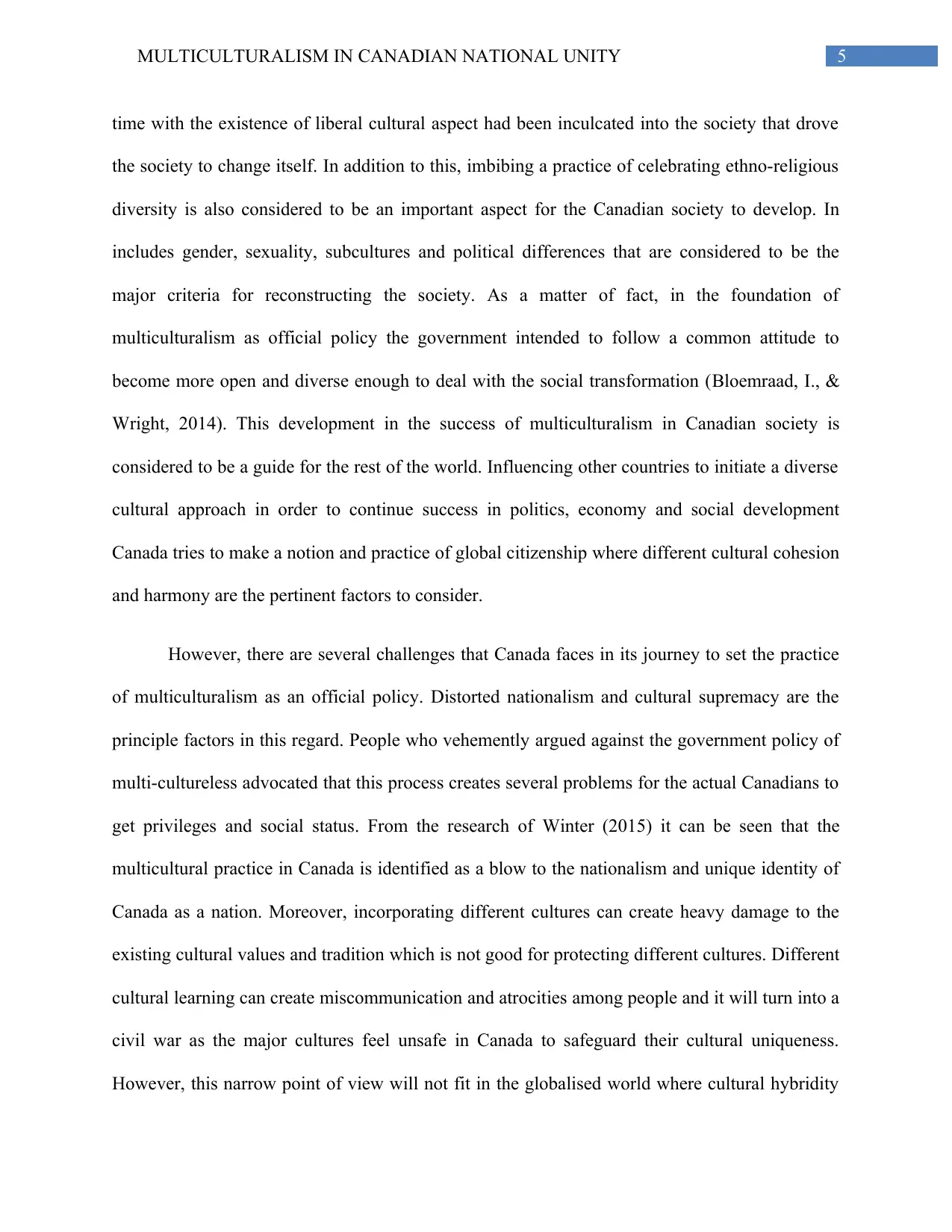
5MULTICULTURALISM IN CANADIAN NATIONAL UNITY
time with the existence of liberal cultural aspect had been inculcated into the society that drove
the society to change itself. In addition to this, imbibing a practice of celebrating ethno-religious
diversity is also considered to be an important aspect for the Canadian society to develop. In
includes gender, sexuality, subcultures and political differences that are considered to be the
major criteria for reconstructing the society. As a matter of fact, in the foundation of
multiculturalism as official policy the government intended to follow a common attitude to
become more open and diverse enough to deal with the social transformation (Bloemraad, I., &
Wright, 2014). This development in the success of multiculturalism in Canadian society is
considered to be a guide for the rest of the world. Influencing other countries to initiate a diverse
cultural approach in order to continue success in politics, economy and social development
Canada tries to make a notion and practice of global citizenship where different cultural cohesion
and harmony are the pertinent factors to consider.
However, there are several challenges that Canada faces in its journey to set the practice
of multiculturalism as an official policy. Distorted nationalism and cultural supremacy are the
principle factors in this regard. People who vehemently argued against the government policy of
multi-cultureless advocated that this process creates several problems for the actual Canadians to
get privileges and social status. From the research of Winter (2015) it can be seen that the
multicultural practice in Canada is identified as a blow to the nationalism and unique identity of
Canada as a nation. Moreover, incorporating different cultures can create heavy damage to the
existing cultural values and tradition which is not good for protecting different cultures. Different
cultural learning can create miscommunication and atrocities among people and it will turn into a
civil war as the major cultures feel unsafe in Canada to safeguard their cultural uniqueness.
However, this narrow point of view will not fit in the globalised world where cultural hybridity
time with the existence of liberal cultural aspect had been inculcated into the society that drove
the society to change itself. In addition to this, imbibing a practice of celebrating ethno-religious
diversity is also considered to be an important aspect for the Canadian society to develop. In
includes gender, sexuality, subcultures and political differences that are considered to be the
major criteria for reconstructing the society. As a matter of fact, in the foundation of
multiculturalism as official policy the government intended to follow a common attitude to
become more open and diverse enough to deal with the social transformation (Bloemraad, I., &
Wright, 2014). This development in the success of multiculturalism in Canadian society is
considered to be a guide for the rest of the world. Influencing other countries to initiate a diverse
cultural approach in order to continue success in politics, economy and social development
Canada tries to make a notion and practice of global citizenship where different cultural cohesion
and harmony are the pertinent factors to consider.
However, there are several challenges that Canada faces in its journey to set the practice
of multiculturalism as an official policy. Distorted nationalism and cultural supremacy are the
principle factors in this regard. People who vehemently argued against the government policy of
multi-cultureless advocated that this process creates several problems for the actual Canadians to
get privileges and social status. From the research of Winter (2015) it can be seen that the
multicultural practice in Canada is identified as a blow to the nationalism and unique identity of
Canada as a nation. Moreover, incorporating different cultures can create heavy damage to the
existing cultural values and tradition which is not good for protecting different cultures. Different
cultural learning can create miscommunication and atrocities among people and it will turn into a
civil war as the major cultures feel unsafe in Canada to safeguard their cultural uniqueness.
However, this narrow point of view will not fit in the globalised world where cultural hybridity
⊘ This is a preview!⊘
Do you want full access?
Subscribe today to unlock all pages.

Trusted by 1+ million students worldwide
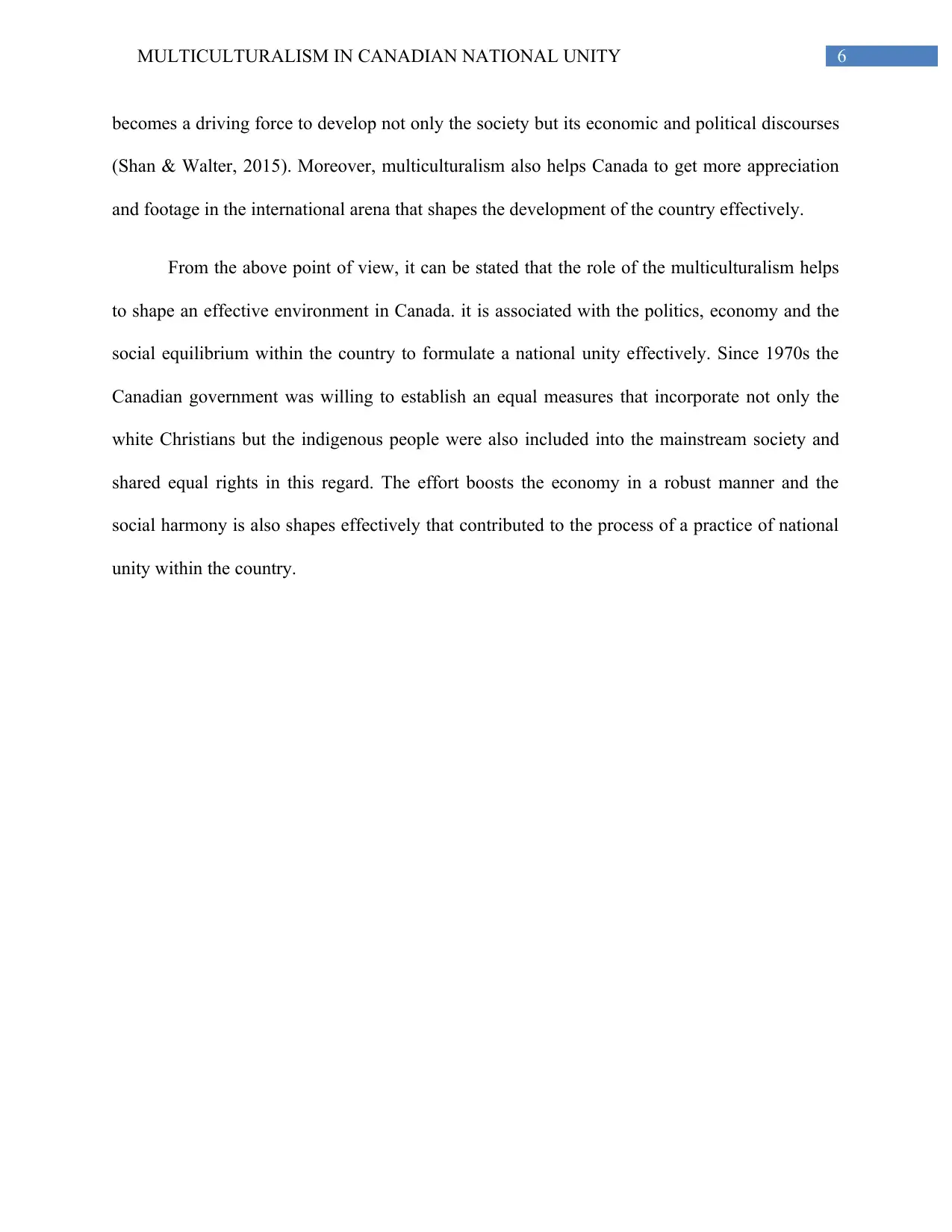
6MULTICULTURALISM IN CANADIAN NATIONAL UNITY
becomes a driving force to develop not only the society but its economic and political discourses
(Shan & Walter, 2015). Moreover, multiculturalism also helps Canada to get more appreciation
and footage in the international arena that shapes the development of the country effectively.
From the above point of view, it can be stated that the role of the multiculturalism helps
to shape an effective environment in Canada. it is associated with the politics, economy and the
social equilibrium within the country to formulate a national unity effectively. Since 1970s the
Canadian government was willing to establish an equal measures that incorporate not only the
white Christians but the indigenous people were also included into the mainstream society and
shared equal rights in this regard. The effort boosts the economy in a robust manner and the
social harmony is also shapes effectively that contributed to the process of a practice of national
unity within the country.
becomes a driving force to develop not only the society but its economic and political discourses
(Shan & Walter, 2015). Moreover, multiculturalism also helps Canada to get more appreciation
and footage in the international arena that shapes the development of the country effectively.
From the above point of view, it can be stated that the role of the multiculturalism helps
to shape an effective environment in Canada. it is associated with the politics, economy and the
social equilibrium within the country to formulate a national unity effectively. Since 1970s the
Canadian government was willing to establish an equal measures that incorporate not only the
white Christians but the indigenous people were also included into the mainstream society and
shared equal rights in this regard. The effort boosts the economy in a robust manner and the
social harmony is also shapes effectively that contributed to the process of a practice of national
unity within the country.
Paraphrase This Document
Need a fresh take? Get an instant paraphrase of this document with our AI Paraphraser
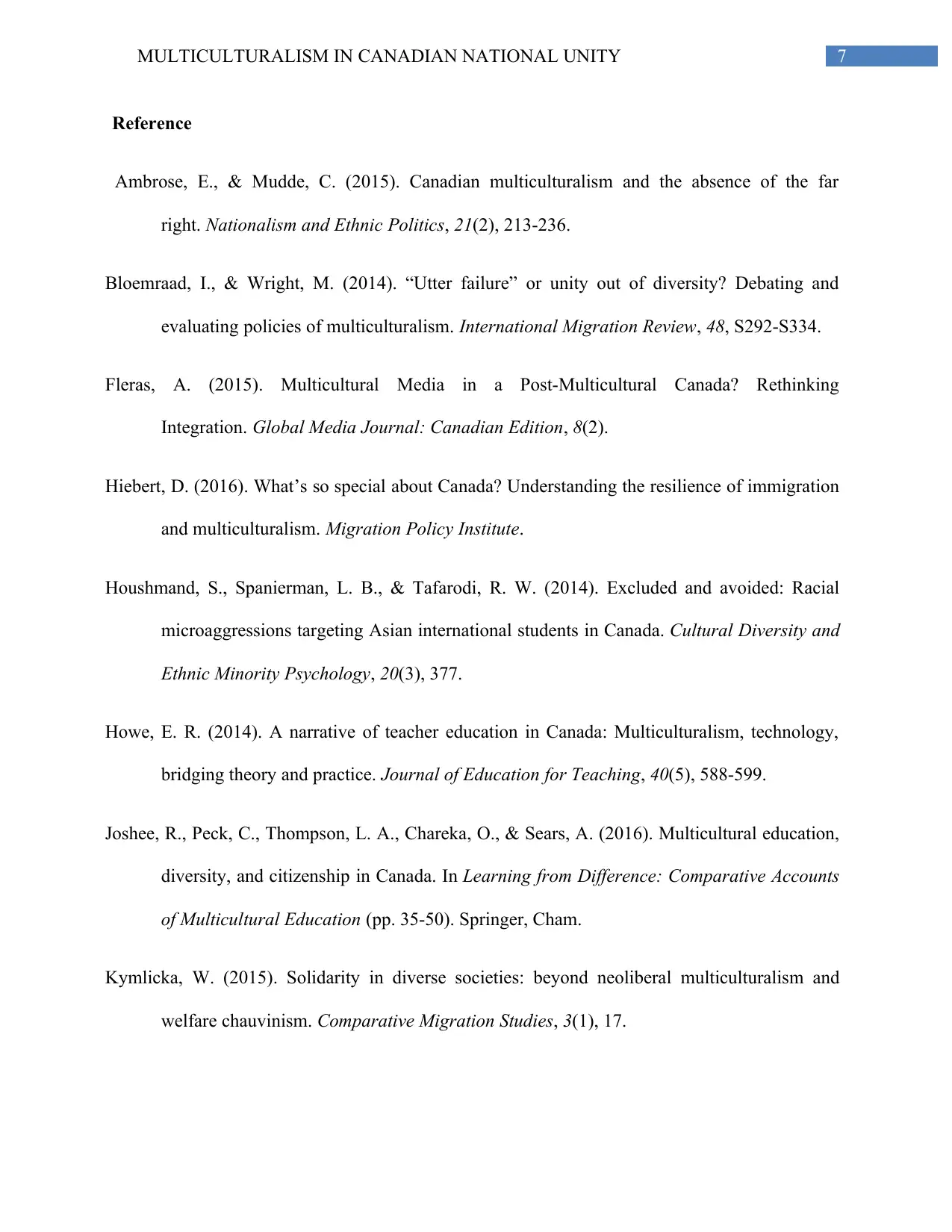
7MULTICULTURALISM IN CANADIAN NATIONAL UNITY
Reference
Ambrose, E., & Mudde, C. (2015). Canadian multiculturalism and the absence of the far
right. Nationalism and Ethnic Politics, 21(2), 213-236.
Bloemraad, I., & Wright, M. (2014). “Utter failure” or unity out of diversity? Debating and
evaluating policies of multiculturalism. International Migration Review, 48, S292-S334.
Fleras, A. (2015). Multicultural Media in a Post-Multicultural Canada? Rethinking
Integration. Global Media Journal: Canadian Edition, 8(2).
Hiebert, D. (2016). What’s so special about Canada? Understanding the resilience of immigration
and multiculturalism. Migration Policy Institute.
Houshmand, S., Spanierman, L. B., & Tafarodi, R. W. (2014). Excluded and avoided: Racial
microaggressions targeting Asian international students in Canada. Cultural Diversity and
Ethnic Minority Psychology, 20(3), 377.
Howe, E. R. (2014). A narrative of teacher education in Canada: Multiculturalism, technology,
bridging theory and practice. Journal of Education for Teaching, 40(5), 588-599.
Joshee, R., Peck, C., Thompson, L. A., Chareka, O., & Sears, A. (2016). Multicultural education,
diversity, and citizenship in Canada. In Learning from Difference: Comparative Accounts
of Multicultural Education (pp. 35-50). Springer, Cham.
Kymlicka, W. (2015). Solidarity in diverse societies: beyond neoliberal multiculturalism and
welfare chauvinism. Comparative Migration Studies, 3(1), 17.
Reference
Ambrose, E., & Mudde, C. (2015). Canadian multiculturalism and the absence of the far
right. Nationalism and Ethnic Politics, 21(2), 213-236.
Bloemraad, I., & Wright, M. (2014). “Utter failure” or unity out of diversity? Debating and
evaluating policies of multiculturalism. International Migration Review, 48, S292-S334.
Fleras, A. (2015). Multicultural Media in a Post-Multicultural Canada? Rethinking
Integration. Global Media Journal: Canadian Edition, 8(2).
Hiebert, D. (2016). What’s so special about Canada? Understanding the resilience of immigration
and multiculturalism. Migration Policy Institute.
Houshmand, S., Spanierman, L. B., & Tafarodi, R. W. (2014). Excluded and avoided: Racial
microaggressions targeting Asian international students in Canada. Cultural Diversity and
Ethnic Minority Psychology, 20(3), 377.
Howe, E. R. (2014). A narrative of teacher education in Canada: Multiculturalism, technology,
bridging theory and practice. Journal of Education for Teaching, 40(5), 588-599.
Joshee, R., Peck, C., Thompson, L. A., Chareka, O., & Sears, A. (2016). Multicultural education,
diversity, and citizenship in Canada. In Learning from Difference: Comparative Accounts
of Multicultural Education (pp. 35-50). Springer, Cham.
Kymlicka, W. (2015). Solidarity in diverse societies: beyond neoliberal multiculturalism and
welfare chauvinism. Comparative Migration Studies, 3(1), 17.
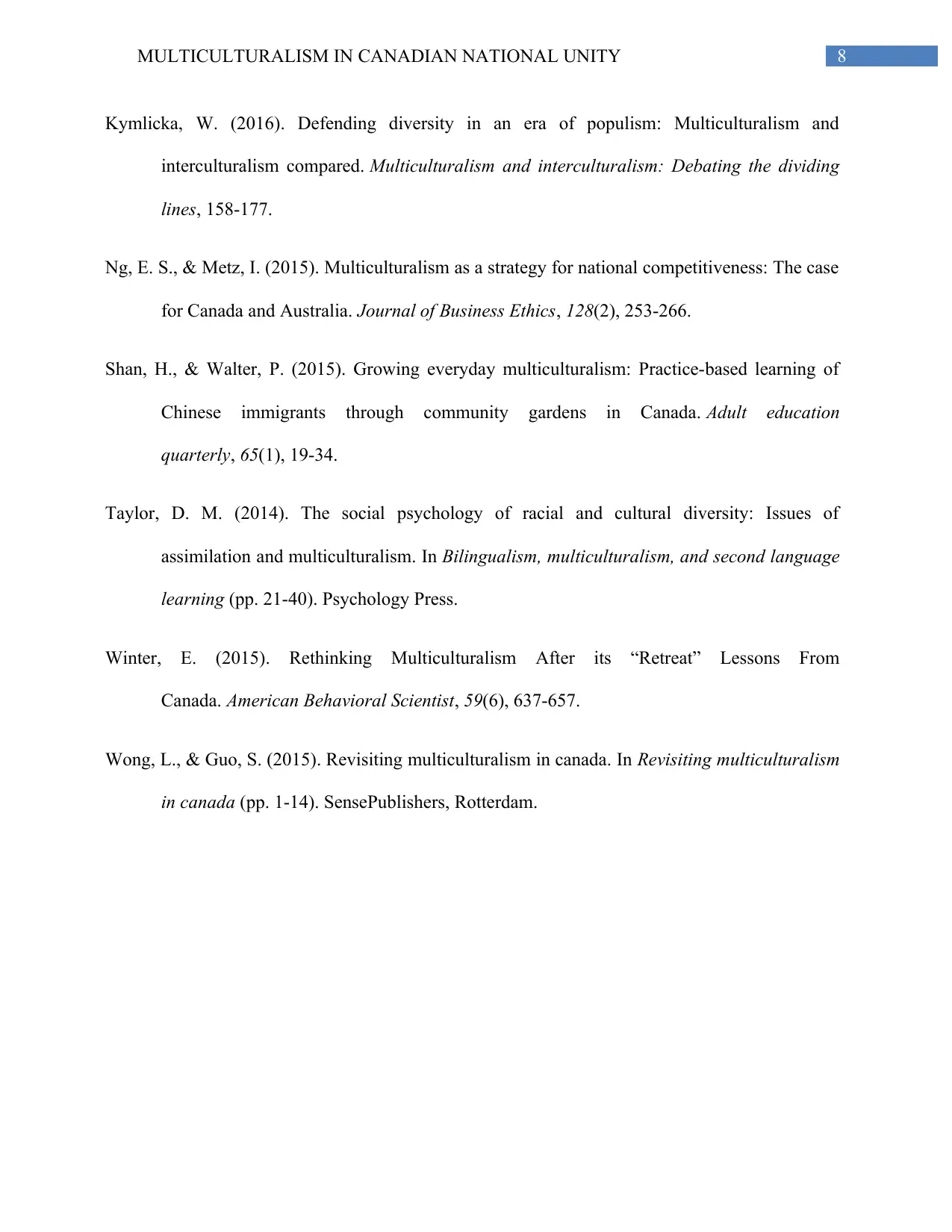
8MULTICULTURALISM IN CANADIAN NATIONAL UNITY
Kymlicka, W. (2016). Defending diversity in an era of populism: Multiculturalism and
interculturalism compared. Multiculturalism and interculturalism: Debating the dividing
lines, 158-177.
Ng, E. S., & Metz, I. (2015). Multiculturalism as a strategy for national competitiveness: The case
for Canada and Australia. Journal of Business Ethics, 128(2), 253-266.
Shan, H., & Walter, P. (2015). Growing everyday multiculturalism: Practice-based learning of
Chinese immigrants through community gardens in Canada. Adult education
quarterly, 65(1), 19-34.
Taylor, D. M. (2014). The social psychology of racial and cultural diversity: Issues of
assimilation and multiculturalism. In Bilingualism, multiculturalism, and second language
learning (pp. 21-40). Psychology Press.
Winter, E. (2015). Rethinking Multiculturalism After its “Retreat” Lessons From
Canada. American Behavioral Scientist, 59(6), 637-657.
Wong, L., & Guo, S. (2015). Revisiting multiculturalism in canada. In Revisiting multiculturalism
in canada (pp. 1-14). SensePublishers, Rotterdam.
Kymlicka, W. (2016). Defending diversity in an era of populism: Multiculturalism and
interculturalism compared. Multiculturalism and interculturalism: Debating the dividing
lines, 158-177.
Ng, E. S., & Metz, I. (2015). Multiculturalism as a strategy for national competitiveness: The case
for Canada and Australia. Journal of Business Ethics, 128(2), 253-266.
Shan, H., & Walter, P. (2015). Growing everyday multiculturalism: Practice-based learning of
Chinese immigrants through community gardens in Canada. Adult education
quarterly, 65(1), 19-34.
Taylor, D. M. (2014). The social psychology of racial and cultural diversity: Issues of
assimilation and multiculturalism. In Bilingualism, multiculturalism, and second language
learning (pp. 21-40). Psychology Press.
Winter, E. (2015). Rethinking Multiculturalism After its “Retreat” Lessons From
Canada. American Behavioral Scientist, 59(6), 637-657.
Wong, L., & Guo, S. (2015). Revisiting multiculturalism in canada. In Revisiting multiculturalism
in canada (pp. 1-14). SensePublishers, Rotterdam.
⊘ This is a preview!⊘
Do you want full access?
Subscribe today to unlock all pages.

Trusted by 1+ million students worldwide
1 out of 9
Related Documents
Your All-in-One AI-Powered Toolkit for Academic Success.
+13062052269
info@desklib.com
Available 24*7 on WhatsApp / Email
![[object Object]](/_next/static/media/star-bottom.7253800d.svg)
Unlock your academic potential
Copyright © 2020–2025 A2Z Services. All Rights Reserved. Developed and managed by ZUCOL.





